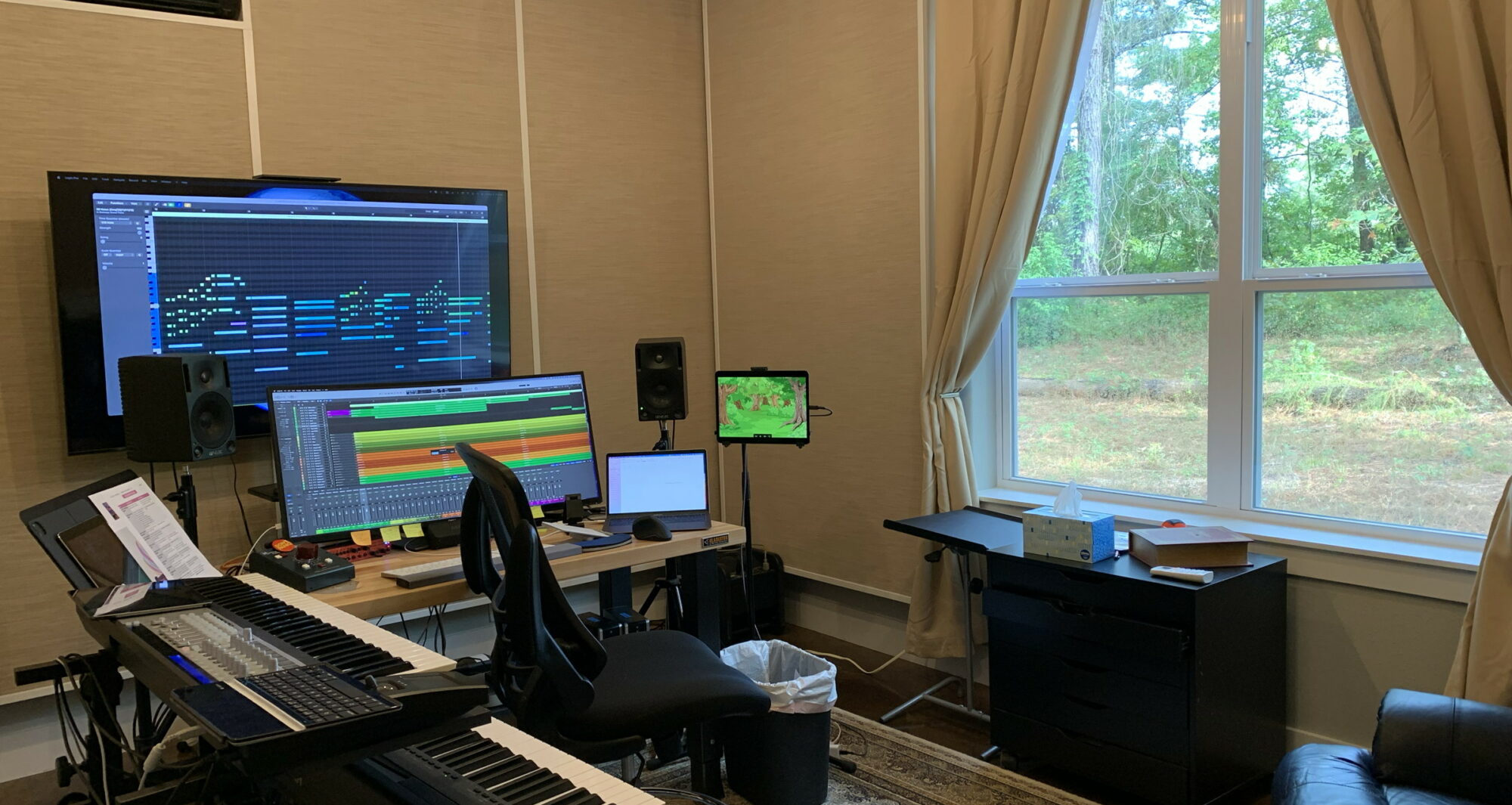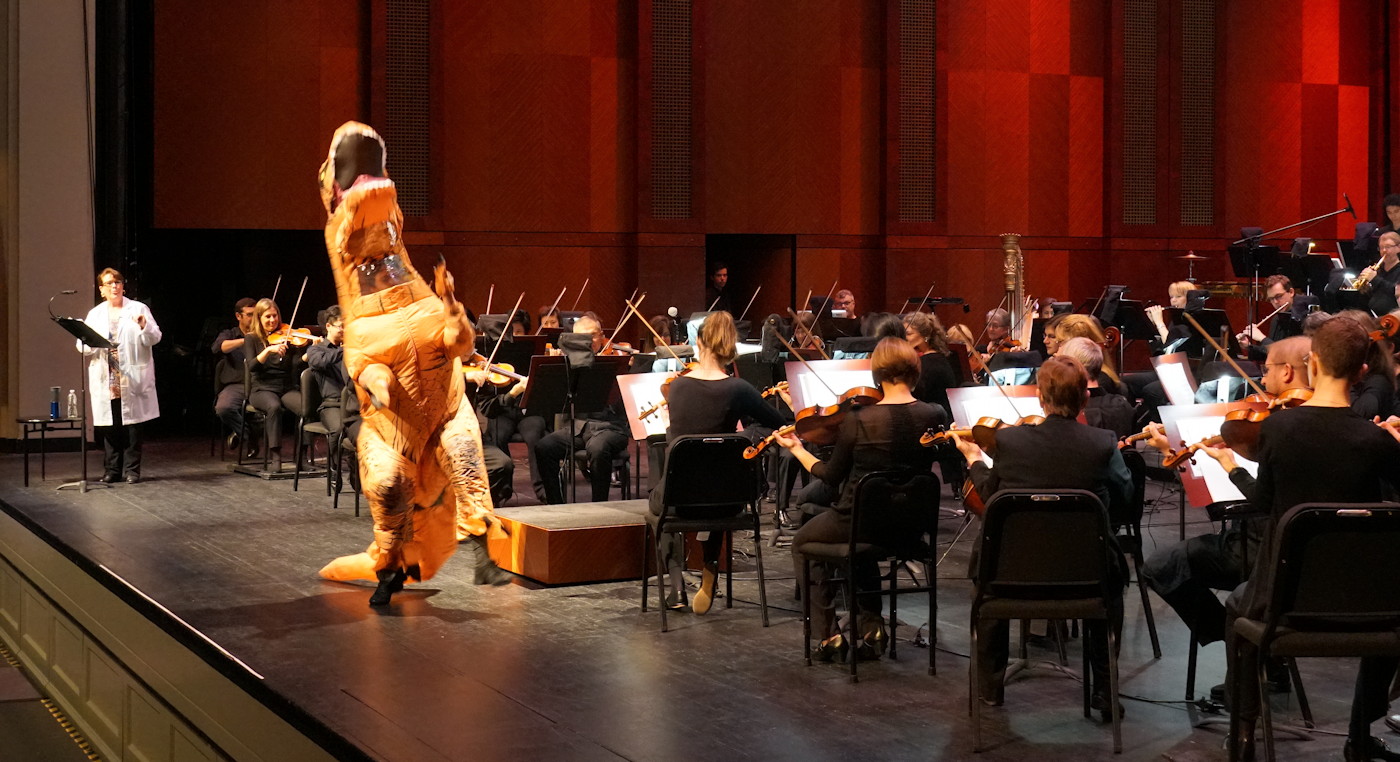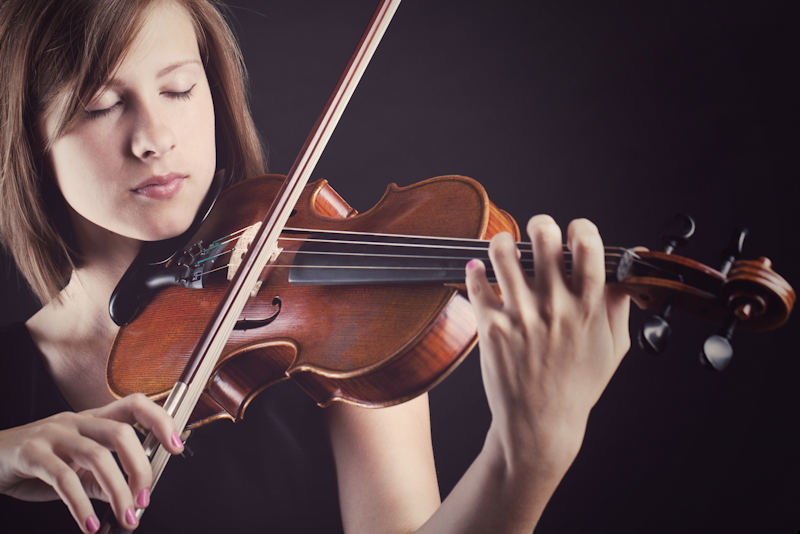Performed June 3, 2023 at the Meyerson Symphony Center, Dallas, Texas
“The Unicorn’s Birthday®” by Bob Singleton – Concert Information Summary
Performance Length: 45 Minutes
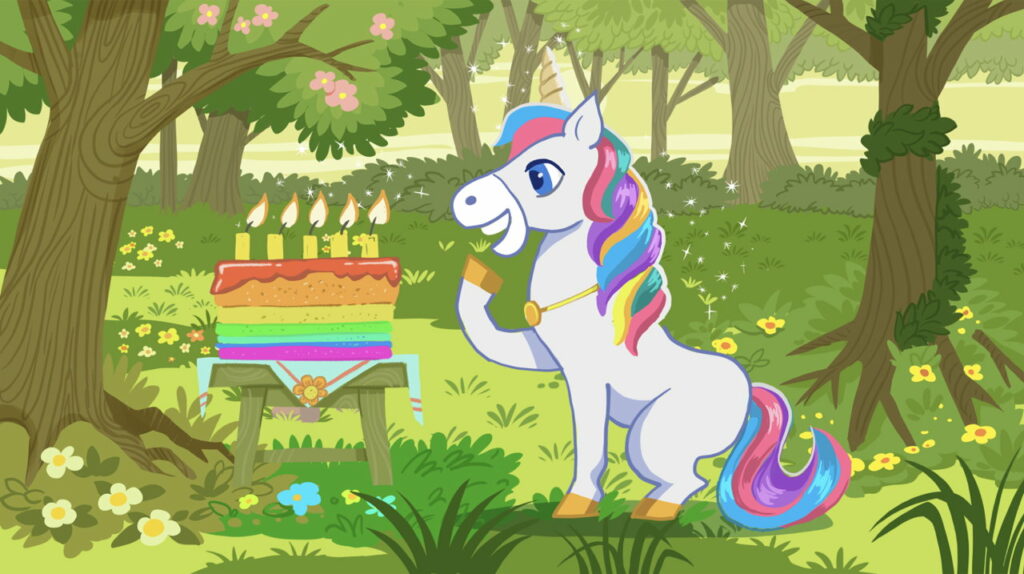
Presented by:
Medium-size double-winds orchestra (see instrumentation below)
Narrator
Inflatable costume character Unicorn (costume available on Amazon)
Special included features:
License allows unlimited performances for entire season
Tiered pricing
Streaming rights for one year
Adorable projection graphics (not required, but helpful)
Brand-able coloring pages for program or lobby activities
Promotional graphics and text
Can be presented as family and/or special needs/sensory-friendly
Delightful on-stage activity by musicians
Gentle audience interactivity
Music & narration never overlap
Three detailed scripts; Narrator, Technical, & Slide Advance
Instrumentation:
2 flutes
1 oboe
1 English Horn
1 Bb clarinet
1 Bb clarinet/bass clarinet
2 bassoons
3 French Horns (with mutes)
3 C trumpets (with straight mutes)
*optional Bb trumpet parts included*
3 trombones (with straight mutes)
3 perc.*
violins 1
violins 2
violas
cellos
contrabass
Note: no piano, harp, tuba, or timpani
*Percussion list:
snare drum (snares on & off)
Tuned percussion: glockenspiel & xylophone
Misc. percussion:
tambourine
wood blocks
finger cymbals
small crash cymbals
small suspended splash cymbal
triangle
ratchet
bell tree
duck call
engraving by Philip Rothman, NYC Music Services
When Instruments Roamed the Earth®! Composer’s Concert Notes & Music Cue Narrative Descriptions
music by Bob Singleton, narration by Stephen White
© 2019 Agnes Day Music, BMI. Used by Permission. All Rights Reserved.
NOTE: “stand/sit” instructions are NOT optional.
The Concert
The Objective
The objective of “When Instruments Roamed the Earth!®” is to present a kinetic, multi-media story-and-music concert event. Just as Looney Tunes introduced a generation to loving classical music, “When Instruments Roamed the Earth!®” takes a new generation on a hilarious journey to love the people, the sound & the experience of the symphony orchestra. It is a modern cartoon approach to inspiring the next generation of symphony lovers & musicians.
The Audience
The core audience for this concert is kids first, and their families second. The orchestra’s job is to create an extraordinary, kid-capturing multi-sensory experience with dynamic sights, sounds and sensations. The music is just part of the entire experience, and the music should be packed with dynamics and fun, and delivered with humor and activity. Once kids have their first “wow” symphony experience, they will be ready to explore the depth and range of the orchestra. They will be hooked.
They enjoy anything that is fun, and funny. They seek heroes. They connect with individuals. They are endlessly curious. They want to see and experience. They don’t want you to explain to them, they want to discover for themselves. And, they want to laugh. They really want to laugh, a lot.
The Presentation
Kids require a multi-sensory experience. They access information using all their senses, and experience life with all senses, simultaneously. Boldly present visuals, seat-shaking sensations, and the full dynamics and textures of the orchestra. It’s difficult to go too far for most kids with all the senses. Let them see and connect to you, the musicians, and their instruments. Give them lots of “in-the-seat” opportunities to interact, with applause, cheers, rhythm, and laughter.
This concert should be free of rules, and full of stimulus. It will be kinetic and dynamic; visually, aurally, and experientially. It won’t be a dramatic arch of theme, development, and long periods of repose. It will be a series of heroic moments with people, images, sounds and humor.
It’s imperative to engage kids in fun and laughter. Laughter is a visceral, whole-body bonding experience for kids. Ignore belly-laughs and fun with kids this age at your peril.
Igor Stravinsky is credited with saying, “I haven’t understood a bar of music in my life, but I have felt it.” Kids are the same. Let kids feel the experience. Don’t explain it to them.
The Payoff
Enjoy. Embrace the way kids enjoy the experience. Have fun. It shows, and kids can read it. Wow them with this concert, and then take them on a rich, music-filled life-journey with the people and music of the orchestra.
Bob Singleton, composer
Dallas, Texas, USA
2019
Composer’s Concert Notes & Music Cue Narrative Descriptions
Q01 “When Instruments Roamed the Earth! Theme”
This cue is an exercise in comic musical pomposity.
Measures 1-11 are reminiscent of 1950’s era science-fiction movie themes for famous black and white movie Japanese monsters. The exuberant, over-the-top tension and noisy dynamics are designed to grab the attention of kids and entertain adults.
Measures 12-20 is a grand fanfare heralding the comic self-importance of the concert, foreshadowing the pomposity and ignorance of the main character, Sir Humphrey Treble-Clef.
Measures 21 to the end is the march theme. Think of it as a theme to “Raiders of the Lost Ark,” if that movie was a slap-stick comedy. This is a continuation of the silly self-importance of the main character, echoing the background music used in cartoons and black and white newsreel footage of famous explorers and national heroes.
Q02 “Sir Humphrey Treble-Clef”
Sir Humphrey is a silly character, who probably achieved his title of “sir” by accident or misunderstanding. When he was a child, his curiosity led him to look at ants through a magnifying glass, whereupon he accidentally set them on fire by focusing the sun on them. He has probably mixed up “right” and “left” all his life and never noticed.
As an adult, his most academic pursuits have been comic books and alien conspiracy theories. The music reflects this character that is oddly out-of-step with the rest of the world, with an off-kilter world view that is funny to everybody besides himself. If it was brought to his attention, he wouldn’t get the joke.
The comic interplay of the flutes, piccolo, and bassoon in mm. 12, 21, and 55-56 reflect his comic character, as does the general musical foolishness and whimsy throughout this cue. There are 1/2 step melodic collisions in the main theme to emphasize Sir Humphrey’s looney personality.
Q03 “Kaboom for Orchestra”
“Kaboom for Orchestra” is a musical depiction of a cartoon archeological site. While nobody in their right mind would use dynamite while unearthing artifacts, Sir Humphrey Treble-Clef has never actually been in his right mind.
The cue starts with a match sonically being struck by the cymbal scrape in m. 1, the fuse being lit and burning with the strings and woodwinds trill in mm. 2-6, the explosion on the downbeat of m. 8, and debris falling depicted by the xylophone in m. 8 b. 3-4.
The general “busy-ness” and hubbub of the archeological site starts at measure 9. The 8th note activity theme in m. 9 is punctuated by more explosions (mm. 19-24, 33-34, 47) a hammer and chisel (m. 37-38, 48-49, 52-53), and using a scrub brush (m. 56-62).
Measure 55 to the end is the lazy end to a long day, with an “Oh, no!” ending. A match is lit by Sir Humphrey at m. 55 with the cymbal scrape, but it seems to go out. At m. 62, we find the fuse is actually lit (violins trill-trombone flutter tongue); while at m. 63, Sir Humphrey gets close to the dynamite, lights a match and tries to light the burning fuse again. A pregnant fermata-silence ensues.
In classic Roadrunner-vs. Wile E. Coyote fashion, after the pregnant pause, the dynamite explodes in m. 64, b. 3. It should be a shock to the audience.
Q04 “String Dinosaurs”
The string sections should be prepared to stand and hold up their instruments or gesture toward their instruments, when cued by the narrator during the talk before this cue.
This cue is a showcase for the strings. It purposely features techniques that are unique to the strings. Standing to show off the techniques allows kids to make a visual and aural connection to things they’ve heard, but may not know how they are created.
This cue starts with a moody, morning-in-the-mist feel, with a lush, amorphous pad-like sound from the woodwinds, strings, and harp. The violin solo depicts a small, lithe dinosaur waking, and stretching in the early morning light and mist.
Measure 19 transitions to the busy life during the day, with the forceful theme by the cellos, double bass, and piano. The aggressive theme is played by the 1st violins. The 2nd violins enter and antiphonally play the theme, demonstrating that there is more than one thing going on in that part of the orchestra, where everybody looks like they are doing the same thing.
The cue demonstrates pizzicato, sul tasto, col legno, marcato, solo and tutti playing. Everything should be played to its maximum effect; the beautiful pads should be lush and the solo should be expressive; the aggressive sections should be marked and punctuated. Players should put their body into their instruments and their parts so that kids will see that playing is not just an intellectual exercise, it’s a mind-soul-body experience.
The cue ends as it began, when the small dinosaur settles down at the end of the day, and with a final punctuation, drops into sleep.
Q05 “Toot Suite for Woodwinds”
The woodwinds should be prepared to stand and hold up their instruments when cued by the narrator during the talk before this cue.
This is a musical section about passing wind. Farting. A booty blast. A panty burp… tastefully presented by the symphony orchestra. If Mozart could refer to it shamelessly, it can be presented to bring laughter to everyone.
This cue presents the image of a chewing dinosaur with the sound of a ratchet and the passing of wind by the third trombone. The humor is enhanced by the dynamic contrast of the light and lyrical passages played by the woodwinds, and the wet, blatty, forte blasts by the third trombone. Extend the “fart” moments for comic effect, if you wish.
By m. 97, our dinosaur hero is feasting on the wind-inducing fauna with wild abandon, as the orchestra plays a sort of loud, drunken waltz. There’s one more big windy release at m. 111, and at mm. 116-117, a comic pause for effect, and then a non-tonal squeak of a singing release by the trumpet buzzing into a mouth-piece.
This will probably be the most memorable and talked-about piece of the whole concert. Embrace the fun.
Q06 “Horns Aplenty”
Brass should be prepared to stand and hold up their instruments when cued by the narrator during the talk before this cue.
This cue is a brass feature. It depicts what starts as a small gathering of “horned” dinosaurs and develops into a “traffic jam” of pushing and blaring by the end.
It showcases horn choir and horn rips, trumpet mutes, trombone slides, and each section with idiomatic themes.
Q07 “Blunder Lizards”
Percussionists should be prepared to strike their instruments when cued by the narrator during the talk before this cue.
This cue is a percussion feature. The percussion should be loud, and their gestures should be bigger than life.
This cue could be subtitled, “Fanfare for a Clumsy Dinosaur.” The narrator’s description is of large, slow, plodding, near-sighted, stumbling behemoths.
The big brassy fanfare and percussion is countered by light, flighty woodwinds, which could be imagined to be smaller, tinier dinos, butterflies, flying raptors, and flying debris that is stirred up by the large reptilian land masses.
Give this your best Olympic-style comic attention.
Q08 “Finale, Part 1”
This is a recap of several previous cues. It should be played with wild abandon.
At the end, the snare continues rolling under narration into the short next cue.
Q09 (only 4 measures) “Cymbalsaurus”
Tension builds as the narrator, over the rolling snare, describes that there is a meteor, hurtling toward Earth. It’s comically revealed that it wasn’t a huge meteor, just a little tiny one that crashed on the head of the Cymbalsaurus.
Q10 “Finale Finish”
There will be an inflatable T-Rex costume character on stage. The audience will go wild. This cue should be played with wild abandon for comic effect while the T-Rex “conducts” the orchestra. Everything is accented and forte, sounding like at every turn, it might finally end. It doesn’t.
There are 3 big, false endings where it sounds like it really might end: mm. 11-12, 25-26, and 43-45.
Shout the text mm. 39 to the end like you’re a cheerleader. Don’t be shy.
***end***
“The Unicorn’s Birthday®” Symphony Concert
a Sensory-Friendly Concert Celebration, commissioned by the Dallas Symphony Orchestra
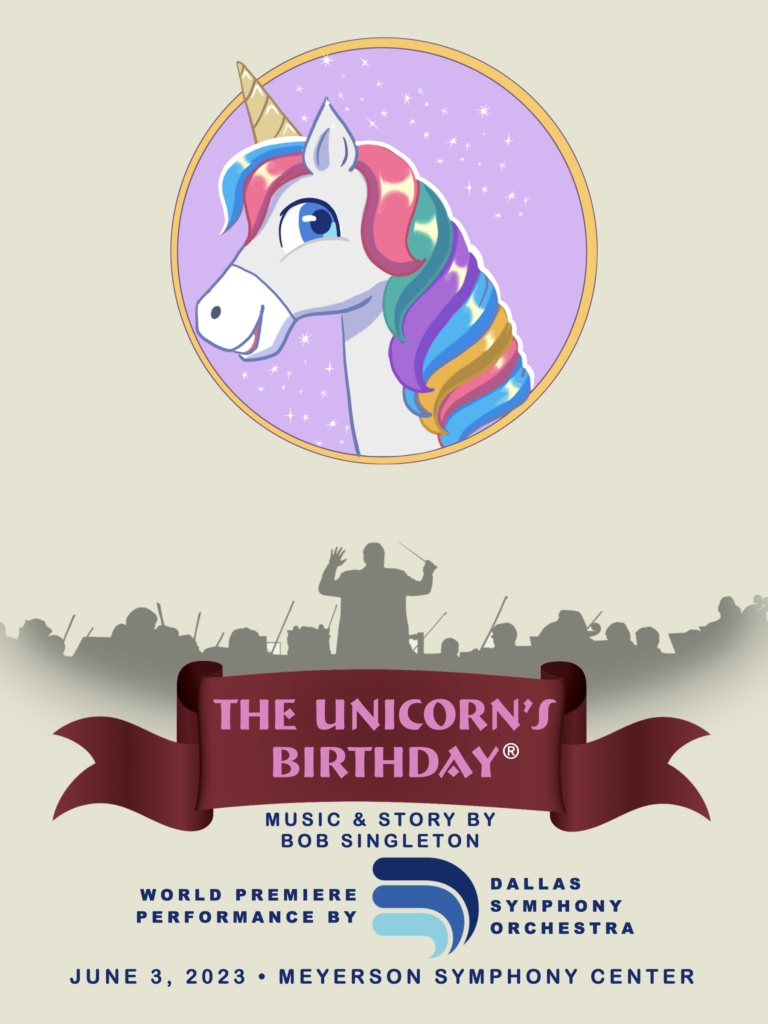
The Dallas Symphony Orchestra commissioned Grammy®-nominated and multi-platinum award-winning composer, Bob Singleton, to create a brand new sensory-friendly concert. This concert was co-commissioned by Savannah Philharmonic and Oklahoma Modern Music Collective.
“The Unicorn’s Birthday®” is a charming, fantasy-and-fun-filled symphony experience with terrific music, fun sounds, captivating on-stage activity, friendly graphics, and gentle audience interactivity.
This new work is a musically satisfying and welcoming concert for young families and special needs audiences. It is perfect for patrons that are OK with moderate audience activity during the performance and wish to enjoy a memorable orchestra experience without loud, sudden noises or musical tension.
The world premiere performance by the Dallas Symphony Orchestra was on June 3, 2023, at the Meyerson Symphony Center in Dallas, Texas. Several other symphonies are planning performances, including Nashville Symphony and the Savannah Philharmonic.
Build strong community goodwill while growing audiences with this heart-warming symphony experience.
Contact me for more information about performances.
Announcing “When Instruments Roamed the Earth!®” vs. 2.0
“When Instruments Roamed the Earth!®” was premiered by the Fort Worth Symphony Orchestra in Bass Performance Hall under conductor Alejandro Gómez Guillén in February 2019.
What do you do after you’ve had a triumphant world premiere of a new type of family concert, by a world-class symphony orchestra, in a revered symphony hall?
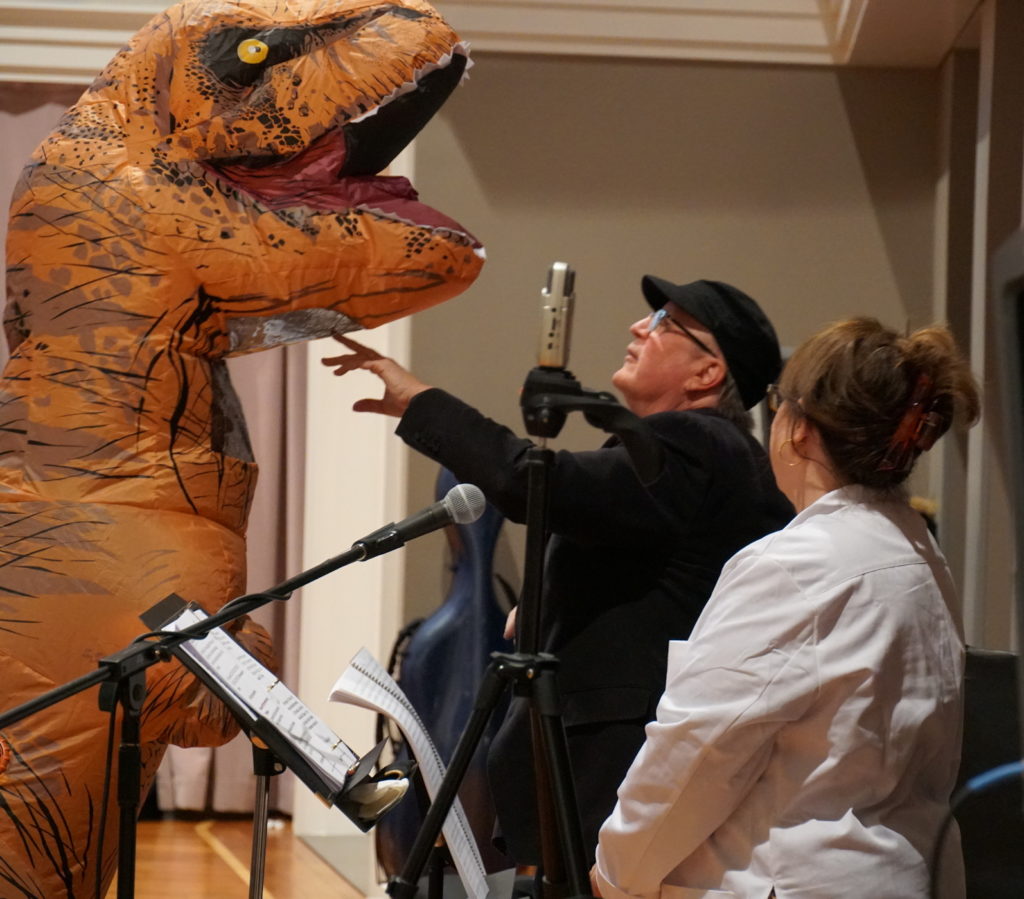
You make it better.
During all the read-throughs, rehearsals and the performance of, “When Instruments Roamed the Earth!®” copious notes were taken, musicians were queried, conductors were questioned, and audience members, production staff and characters were surveyed; all to find out, “how can we make this better?”
We found out. Then, we went to work on version 2.0.
“When Instruments Roamed the Earth!®” version 2.0 includes:
- a big laugh that was added earlier in the narration to get the fun started sooner and larger
- revamped orchestration, reworked in key areas
- all scores and parts were totally re-engraved using a unified “house style,” with fresh paginations, layouts, instructions, and markings for quicker rehearsals and better performances
- the title change was rolled out to all scripts, scores, parts, graphics, and promotional elements (“When Instruments Roamed the Earth!®” was originally titled “Jurassic Parts.” Questions about that? Funny story. Ask us.)
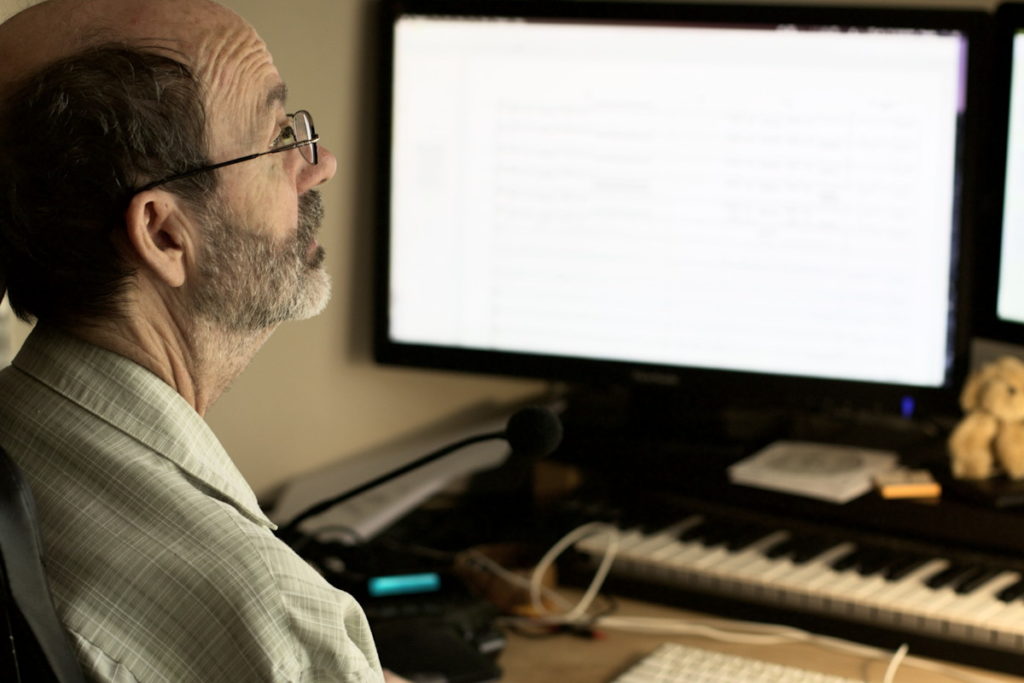
Contact Bob Singleton now for more information: bobs@singletonproductions.com

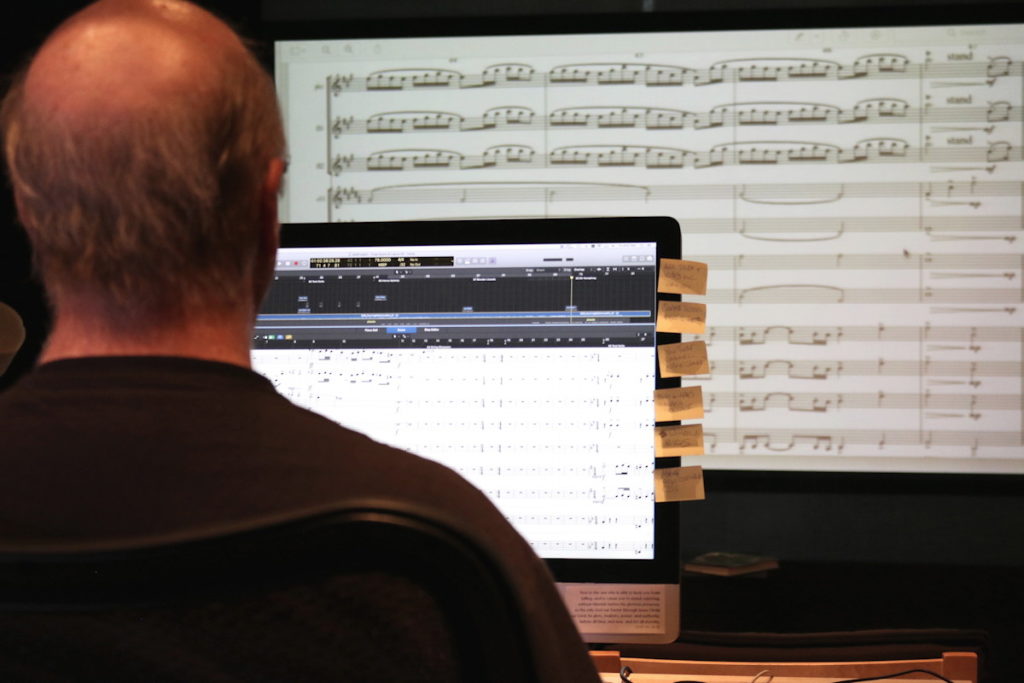
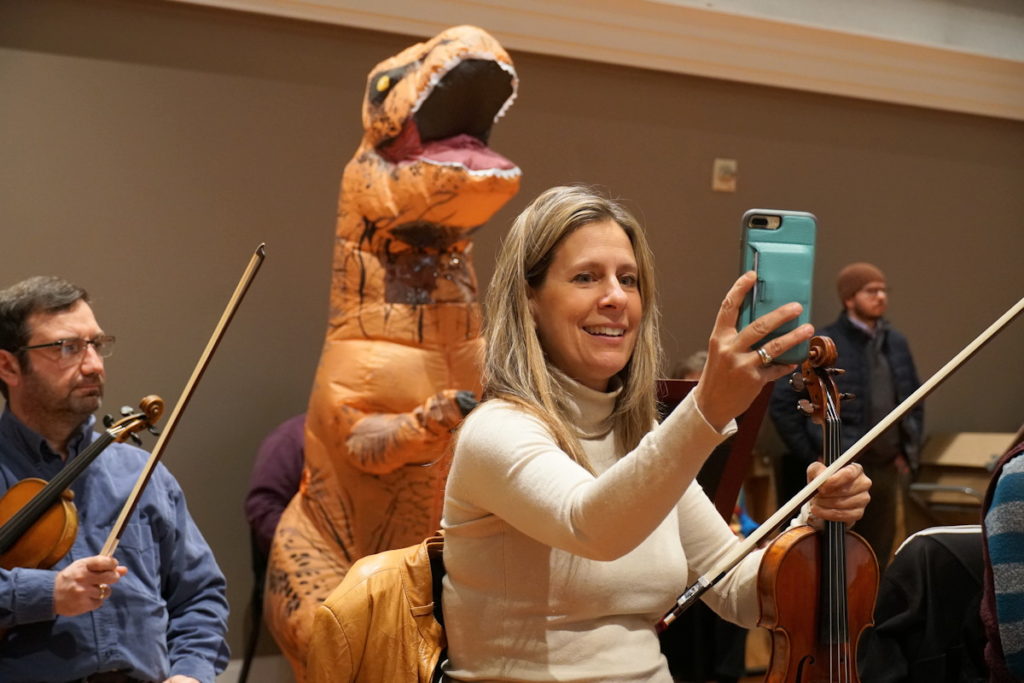
If Barney the Dinosaur Were Growing Your Orchestra’s Audience, Here’s What He’d Do.
Kids, Concerts, and Cultivating Crowds
A manifesto for building orchestra audiences
by Bob Singleton
I’m a classically trained composer and producer, who has written for orchestras, recordings, commercials, TV, and movies. My information about kids comes from being privy to research during my years as music director for one of the most popular music-driven properties in the history of kids programming on PBS, Barney the Dinosaur®.
I heard and participated in discussions of research about kids, toddlers through teens, that provide a template to capture and enchant kids and families. I’ve seen that research bear fruit with several projects.
I’m going to share how it will work for the music and people that I love, the symphony orchestra.
A kid goes to his first orchestra concert. As the orchestra takes its first long, quiet pause, the kid turns to his mother and asks, “Why is it called a movement, if they just sit there?”
Orchestras everywhere are trying to capture new audiences, and kids and families are among the most coveted sources for new audiences. Organizations of all kinds that deftly connect with kids and families, know it happens by knowing who kids are, and when and how to capture them. Experienced marketers also know that when they capture a kid at the right age, they are connecting with the whole family’s interests and purchasing power–often for a lifetime.
Paraphrasing a quote attributed to everyone from Oprah Winfrey to Spongebob; after attending an orchestra concert, kids may not remember a note that was played, they may briefly remember something that was said, but they will always remember how they felt. The best organizations make certain that kids feel enchanted by what they experience.
Kids, life, and music
Kids breathe music from birth. Kids connect with music to develop language, structure, intellect, and more. Music, for kids, is at its most captivating when it is connected with human interaction–and music and human interaction is at the core of every live orchestra experience.
The best age to capture kids for the symphony is roughly ages 6 to 10. Kids this age are intellectually and developmentally prepared to be affected by a life-changing experience at the symphony.
At this impressionable age, kids aren’t locked into a musical identity. They are aspirational and seek heroes. They connect with individuals, not institutions. They access information using all their senses and experience life with all senses simultaneously. They are endlessly curious. They want to see and experience. They don’t want you to tell them, they want to discover for themselves. And, they want to laugh. They really want to laugh. A lot.
This age can be summed up in two words: discover, and laugh. Hit the mark on those two concepts with kids this age, and you’ve captured your new audience, and importantly, their families with them.
First impressions
Kids want to have fun, yet orchestras often feel most comfortable dishing out information, not feeding out fun. When that happens, nobody wins. If orchestras offer a serving of uninspiring educational vegetables for a kid’s first experience, they lose their only “first chance” with that kid.
Kids must first be thrilled. Early orchestra experiences should be a 9-year-old’s dream: exciting, filled with age-appropriate sights, sounds, and sensations that make them laugh and want more.
Igor Stravinsky is credited with saying, “I haven’t understood a bar of music in my life, but I have felt it.” Kids are the same. Let kids feel the experience. Don’t explain it to them.
A kids and family concert will be different from a “grown-up’s” concert. Embrace the difference. The virtuoso music of the masters isn’t required in your kids concerts. What’s required is music that creates an extraordinary, kid-capturing multi-sensory experience, full of sights, sounds, and sensations. The music is part of the entire experience, and it should be packed with dynamic fun, delivered with humor and activity. Once kids have their first “wow” experience, they will be ready to explore the depth and range of the orchestra. They will be hooked.
That first experience should not be a quiet classroom in a concert hall. It should look like kids–with wiggles, heads on a swivel, bouncing, and chatter. The object is to channel that kid-energy into a love for the orchestra, not chain it to a seat.
Kids require a multi-sensory experience. Boldly present visuals, seat-shaking sensations, and the full dynamics and textures of the orchestra. Make the most of projection, plus, let them see and connect to your conductor, the musicians, and their instruments. Give them lots of “in-the-seat” opportunities to interact, with applause, shouts, rhythm, and laughter.
A kids and family concert will be free of rules and full of stimulus. It will be kinetic and dynamic; visually, aurally, and experientially. It won’t be a slow dramatic arch of theme, development, and long periods of repose. It will be a series of heroic moments with people, images, sounds, and humor. Kids should leave feeling a sense of “wow,” wanting to tell their friends how it was so cool.
It’s imperative to engage kids in fun and laughter. Laughter is a visceral, whole-body bonding experience for kids. Ignore belly-laughs and fun with kids this age at your peril.
Plan it
When planning your kids and family concert, keep it under 50 minutes, and follow these guidelines:
- Start with a “wow” opening.
- Create kinetic action within the orchestra. Break the wall of the first row of musicians by having sections and soloists frequently stand and sit for action and visibility.
- Showcase individuals, instruments, and dynamics with “heroic moments” that feature soloists and sections.
- Add kid-friendly projections with pictures and little-to-no text.
- Mix music and dialog in alternating, quick doses. Dialog must be age-appropriate and include large amounts of elementary-age humor.
- Include “in-the-seat” interaction–clapping, laughing, cheering, and call-and-response.
- Create concert titles, subjects, ideas, or characters that connect with kids.
- Don’t depend on performing “familiar” concert works. It’s possible that all orchestral repertoire is unfamiliar to your audience. Connect using fun, interesting sounds and textures, and compelling sights.
- Let your audience learn by observation, not by lecture.
- End with a big, noisy, fun, grand finale, and no talking or lecturing. Leave the audience cheering, laughing, and wanting more.
Include pre-and-post concert lobby multi-sensory experiences that connect with the program. Create development opportunities with businesses and organizations that also want to reach kids and families.
Be bold
Go, capture, and build your new audience. Reach out every season. After you “wow” and captivate your new audience of life-long orchestra lovers, the opening joke in this article could be followed with this:
A kid goes to his second orchestra concert. As the orchestra takes its first long, quiet pause, he turns to his mother and says, “I prefer the atonal, aleatoric intricacies of post-modernism.”
OK–maybe not. Wow them first, then take them on a life-journey with the people and music of your orchestra.
***
Bob Singleton is a Grammy® and Dove nominated composer and producer of music for all ages. He has arranged and produced two RIAA Certified Platinum award albums, and had music in the triple Academy Award nominated movie, “In America,” in addition many other projects for network TV and international distribution.
His kids and family concert for symphony orchestra, narrator and projected graphics, “When Instruments Roamed the Earth!®” was premiered by the Fort Worth Symphony Orchestra at Bass Hall in their 2018-2019 season. He can be contacted at bobs@singletonproductions.com.
